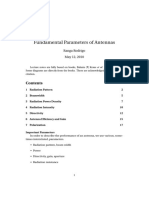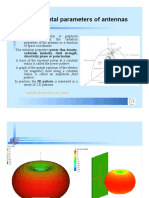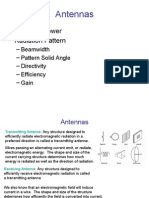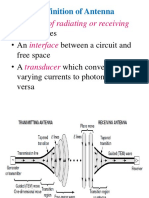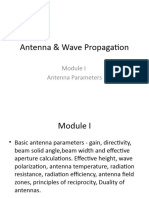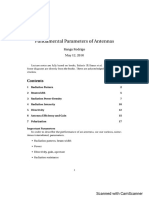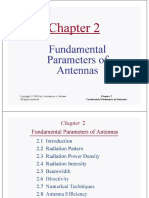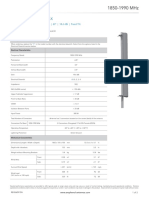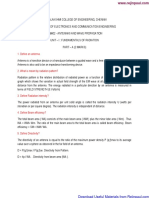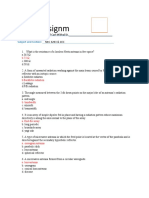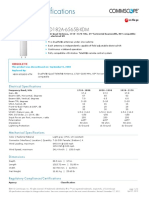100% found this document useful (1 vote)
65 views32 pagesLecture 2 - Parameters
1. An antenna radiation pattern is a graphical representation of the radiation properties of the antenna as a function of space coordinates. It shows the variation of power, field strength, or other antenna parameters with direction away from the antenna.
2. Key characteristics of antenna radiation patterns include the main lobe which indicates the maximum radiation direction, minor lobes, half-power beamwidth (HPBW) which indicates the angular width of the main lobe, and first null beamwidth (BWFN) which is the angular separation between the first nulls on either side of the main lobe.
3. The directivity of an antenna is defined as the ratio of the maximum radiation intensity to the average radiation intensity over all directions, and
Uploaded by
Sagar PrateekCopyright
© © All Rights Reserved
We take content rights seriously. If you suspect this is your content, claim it here.
Available Formats
Download as PDF, TXT or read online on Scribd
100% found this document useful (1 vote)
65 views32 pagesLecture 2 - Parameters
1. An antenna radiation pattern is a graphical representation of the radiation properties of the antenna as a function of space coordinates. It shows the variation of power, field strength, or other antenna parameters with direction away from the antenna.
2. Key characteristics of antenna radiation patterns include the main lobe which indicates the maximum radiation direction, minor lobes, half-power beamwidth (HPBW) which indicates the angular width of the main lobe, and first null beamwidth (BWFN) which is the angular separation between the first nulls on either side of the main lobe.
3. The directivity of an antenna is defined as the ratio of the maximum radiation intensity to the average radiation intensity over all directions, and
Uploaded by
Sagar PrateekCopyright
© © All Rights Reserved
We take content rights seriously. If you suspect this is your content, claim it here.
Available Formats
Download as PDF, TXT or read online on Scribd
/ 32

